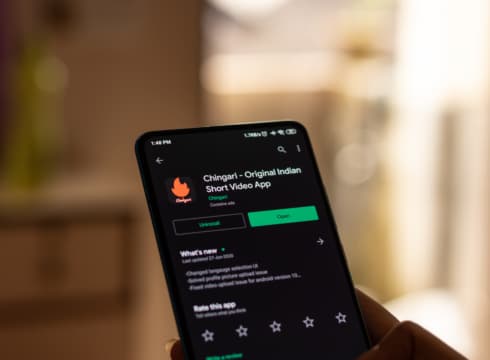To push profitability, Chingari is spending less than INR 1 Cr a month on user acquisition; the startup is also focussing on streamlining its workforce
Inc42 reported earlier that Chingari was seen building an adult entertainment app with salacious ads and promos
In FY22, it reported a net loss of INR 139.4 Cr, a jump of 225.7% from INR 42.8 Cr in FY21
Inc42 Daily Brief
Stay Ahead With Daily News & Analysis on India’s Tech & Startup Economy
Short-video sharing platform Chingari has turned operationally profitable, Chingari CEO and cofounder Sumit Ghosh claimed.
“We are finally profitable and will do business with our monthly revenues from now on. Not burning VC cash anymore or need to raise to sustain the business. We still have a few million USD left in the bank, which we have kept aside for the rainy days,” Ghosh claimed on Twitter.
The announcement comes at a time when Chingari has laid off more than 50% of its workforce in the second round of layoffs within two months. The layoffs impacted employees from product, customer support, design and marketing teams.
Navigating The Path To Profitability
In the startup’s early stages, he stated that the primary objective was rapid growth, regardless of cost. The startup invested heavily in acquiring users through inorganic means without giving much thought to revenue generation or a sustainable business model, he said. He was of the view that money would follow if Chingari was able to show growth.
“In 2022 Markets turned, mid of 2022 even though we were growing at 500K downloads a day, no VC would take a bite as there was no clear monetisation plan. I realised this won’t lead us anywhere, reduced all inorganic media buys, focused on quality user acquisition, users who can be monetised,” Ghosh added.
At present, the startup is allocating less than INR 1 Cr per month for user acquisition, with a Customer Lifetime Value (LTV) to Customer Acquisition Cost (CAC) ratio of 4:1. Chingari kicked in monetisation strategy in May 2023 and anticipates improved financial metrics soon. According to Ghosh, profits generated each month will be reinvested to fuel further growth.
“When we raised funds, specially around GARI launch, we had raised lots of capital. We thought oh now we will become a big company, we need to hire professional people across the board, this was our biggest mistake, along with the good guys, we actually hired a bunch of corporate bozos who just came, did nothing, gave corporate Gyan and warmed chairs all day and left,” Ghosh said in his recent Twitter post.
Ghosh added that the Bengaluru-based startup eventually fired them due to low delivery, while the startup overspent on this talent pool.
He also acknowledged that building a D2C business and figuring out a viable business model is difficult in India as the companies have to pay Google or Facebook to acquire users, Google or Apple 30% tax on all the store billed payments, pay a GST on the income from users, among other expenses.
Last week, the startup laid off more than 50% of its workforce after firing 20% of its workforce in June. Chingari now has an employee base of 50-60 only following the latest round of layoffs.
While it is cutting costs on employee expenses and finding more avenues to profitability, it recently became a digital partner of the UK-based Southall FC, an eighth-division football club. Chingari will offer a range of digital services to help enhance the club’s online presence and fan engagement.
Chingari In Troubled Waters
Founded in 2018 by Sumit Ghosh, Aditya Kothari, Biswatma Nayak and Deepak Salvi, Chingari rose to prominence after the Indian government banned Tiktok and other Chinese apps in 2020, citing security concerns. Earlier this year, its cofounder, Kothari, exited the startup.
At the beginning of this year, Chingari received an undisclosed amount of equity funding from Aptos Labs, the company behind the launch of Layer 1 blockchain Aptos. Last year, the short video startup secured $15 Mn in a funding round led by Republic Capital.
In October 2021, it introduced a crypto token named $GARI and a non-fungible token (NFT) marketplace. $GARI is the native token of Chingari and enables short-form video creators to monetise their content on the blockchain. As per CoinMarketCap, GARI was trading at a value of $0.01393 on Monday (August 28th), 98.67% down from its highest value of $1.05 in January 2022.
This year, Chingari forayed into 18+ content with paid live one-on-one calls between creators and users to improve engagement and increase app downloads.
In an extensive investigation, Inc42 also found a series of recruitment posts for creators with promises of big payouts, in addition to several social media ads and videos featuring salacious promises.
The creators on the platform were found encouraging users to make 1-on-1 calls, and most users tend to accept them upon receiving an in-app gift. While it could be one of the ways to monetise the platform, the moral and ethical questions arise if Chingari can take this route.
In FY22, the startup reported a net loss of INR 139.4 Cr, a jump of 225.7% from INR 42.8 Cr in FY21. Meanwhile, the total income rose 137X to INR 49.4 Cr from INR 36 Lakh in FY21.
{{#name}}{{name}}{{/name}}{{^name}}-{{/name}}
{{#description}}{{description}}...{{/description}}{{^description}}-{{/description}}
Note: We at Inc42 take our ethics very seriously. More information about it can be found here.


